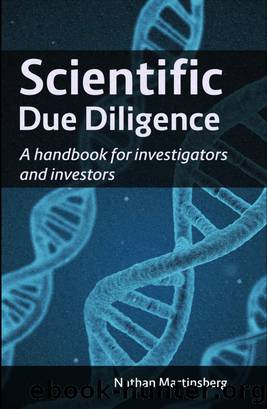Scientific Due Diligence by Nathan Martinsberg

Author:Nathan Martinsberg
Language: eng
Format: epub
Tags: biotechnology, clinical trials, drug development, biotech startup, investing in biotechnology, pharmaceutical due diligence, pharmaceutical venture capital
Publisher: Nathan Martinsberg
Chapter 8. Clinical trials
Clinical trials are the ultimate test of whether a drug is suitable for its use as a human pharmaceutical. A prospective drug must pass a number of clinical trials prior to approval. Many, many drugs will fail at this point, usually due to a lack of efficacy or unexpected safety problems. This risk of failure should always be taken into account when examining new technologies for investment.
The importance of clinical trials leads to a huge amount of pressure to succeed â this pressure means that many companies will look for any possible way to spin the results in their favour. Tricky statistics, recast outcomes, and subgroup analyses will pop up almost everywhere, inevitably making the drug seem better than it actually is. Those performing scientific due diligence will need to be even more careful than at other stages.
Clinical trials are divided into Phases, ranging from Phase I through to Phase IV, with each subsequent phase being larger and more expensive than the previous one.
Phase I trials are safety trials, most often conducted using healthy volunteers and designed to identify side effects associated with the drug. Every drug has unwanted effects, Phase I trials are necessary to determine what they are and whether they are dangerous. The trials also study ADME (absorption, distribution, metabolism, and excretion) â how the drug is taken up by the body, shuttled around from organ to organ, broken down into other compounds, and gotten rid of. This information is combined with ascending dose studies, in which the dosage of therapeutic is slowly increased over time to determine the point at which safety concerns occur, to determine what the most likely therapeutic dosage should be in later work. The majority of small biotech firms will have a compound or two in Phase I trials.
Phase II trials begin to focus on efficacy, taking place in patients rather than the healthy volunteers of Phase I. The numbers involved are small, usually less than a few hundred, and will often involve multiple treatment arms in which patients are given different dosing regimens to see which is the most effective. Phase II is usually too small to definitively state whether a drug is beneficial or not, but it provides the scientific data which the later studies will build from. Successfully passing Phase II will provide the first major boost to a biotech start-up and is usually the trigger for another round of investment by larger firms (this is often agreed upon in the licensing or investment terms).
Phase III is much larger, involving hundreds to thousands of patients spread across many different medical centres. The trial size provides an excellent overview of potential safety issues, in particular long-term or rare effects, and so are carefully examined by regulatory authorities. The size and duration of these studies comes with a correspondingly high price tag which ensures that Phase III trials are reserved for a pharmaceutical companyâs best prospects. Phase III compounds will nonetheless often fail to meet the defined clinical endpoint, disappearing in a short flurry of newspaper articles.
Download
This site does not store any files on its server. We only index and link to content provided by other sites. Please contact the content providers to delete copyright contents if any and email us, we'll remove relevant links or contents immediately.
Life 3.0: Being Human in the Age of Artificial Intelligence by Tegmark Max(4523)
The Sports Rules Book by Human Kinetics(3597)
ACT Math For Dummies by Zegarelli Mark(3568)
The Age of Surveillance Capitalism by Shoshana Zuboff(3434)
Blood, Sweat, and Pixels by Jason Schreier(3141)
Unlabel: Selling You Without Selling Out by Marc Ecko(2992)
Urban Outlaw by Magnus Walker(2953)
Hidden Persuasion: 33 psychological influence techniques in advertising by Marc Andrews & Matthijs van Leeuwen & Rick van Baaren(2793)
The Pixar Touch by David A. Price(2746)
Bad Pharma by Ben Goldacre(2737)
Project Animal Farm: An Accidental Journey into the Secret World of Farming and the Truth About Our Food by Sonia Faruqi(2668)
Brotopia by Emily Chang(2596)
The Content Trap by Bharat Anand(2499)
Slugfest by Reed Tucker(2425)
The Airbnb Story by Leigh Gallagher(2380)
Kitchen confidential by Anthony Bourdain(2323)
Coffee for One by KJ Fallon(2019)
Smuggler's Cove: Exotic Cocktails, Rum, and the Cult of Tiki by Martin Cate & Rebecca Cate(1996)
Beer is proof God loves us by Charles W. Bamforth(1937)
